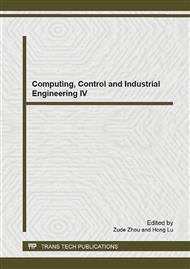[1]
Moore K E, Gungor A, Gupta S M. Petri net approach to disassembly process planning for products with complex AND/OR precedence relationships. European Journal of Operational research, Vol. 135(2001), pp.428-449.
DOI: 10.1016/s0377-2217(00)00321-0
Google Scholar
[2]
Zussman E, Zhou M C. A methodology for modeling and adaptive planning of disassembly processes. IEEE Transaction on Robics and Automation, Vol. 15(1999), pp.190-194.
DOI: 10.1109/70.744614
Google Scholar
[3]
Tsai C. Kuo. Disassembly Sequence and cost analysis for electromechanical product. Robotics and Computer Integrated Manufacturing. Vol. 16(2000), pp.43-54.
DOI: 10.1016/s0736-5845(99)00048-4
Google Scholar
[4]
Liang Yongqiang, Zhong Yanru. An in provement of the algorithm for generation of mechanical disassembly sequences base on cut-set. Modern manufacturing engineering, Vol. 11(2005), pp.37-40.
Google Scholar
[5]
Guo Weixiong, Liu Zhifeng, Liu Guangfu, Pan Xiaoyong, Huang Haihong. Disassembly Sequence Planning Based on Modularization. Journal of computer-aided design and graphics. Vol. 17(2005), pp.498-504.
Google Scholar
[6]
Feng Chun Li Bolin. Solving the TSP orderly genetic algorithm. Southwest jiaotong university journal. Vol. 5(1997), pp.528-533.
Google Scholar
[7]
LI J R, TOR S B, KHOOL L P. A Hybrid Disassembly Sequence Planning Approach for Maintenance. Transactions of the ASME, Vol. 1(2002), pp.28-37.
Google Scholar


